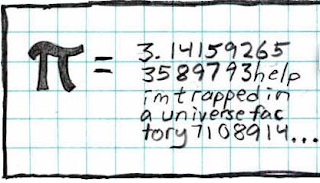When choosing a series to feature on this blog, I normally try to use one that I can be reasonably certain that the majority of my audience will be unaware of. Knowing that, some of you may be wondering why I decided to feature XKCD on this blog. However, I have previously assumed that the majority of my readership would be people who are familiar with internet culture. However, this is so far not been the case. As such, I feel that about half of my current readership will most likely have never heard of XKCD in the first place. And even if they have, its introduction serves as an excellent setup for another series that I plan to feature in this blog. But more on that later.
XKCD is one of the most popular comics on the web. It has well over a million readers, and is one of a small number of webcomics to have a successful print run. XKCD sold 25,000 copies within its first six months in print, followed by a nationwide book tour that raised $32,000 for charity; most webcomics, even successful ones, can only sell printed versions as demanded from online stores, if they even have print versions in the first place. The number of webcomics that have had print versions sold in bookstores at all can be counted on your hands.
But I'm getting ahead of myself.
XKCD began with a student named Randall Munroe who had a tendency to doodle during his classes. These doodles were usually humorous, and usually had something to do with the subject material being taught in class. Then one day in 2005, Randall decided to dig through his notebooks, scan his doodles, and upload them to the internet.
It wasn't especially popular at first -- the low quality of the scans and art didn't help this much, seeing how they were not originally intended to be seen by anyone other than Munroe himself. However, he fixed this in short order, writing strips specifically for the internet. And one of these strips was the now famous "Map of the Internet," an attempt to show a physical representation of where internet content was based using IP addresses, something more adequately explained by the comic itself. This comic was subsequently featured on the popular technology website "Slashdot" (A site which, for the record, I won't be featuring any time in the foreseeable future -- despite my love for the internet, I'm just plain not into the technology side of things). This attracted massive amounts of attention to the series, creating a sizable boom in readership that spread from there via linkage and word of mouth.
But enough about its popularity; let's move on to the comic itself. The most immediately notable element of the comic is that the parts of it that actually feature people instead of graphs and the like -- about three quarters of the comic, at least of late -- are drawn solely in stick figure. This by itself isn't highly unusual for a webcomic -- The similarly famous "Order of the Stick" did much the same, doing so two years before XKCD did. However, unlike Order of the Stick or many similar webcomics, XKCD uses the absolute minimum of detail (Something that many Stick Figure Comics do not do, surprisingly enough) -- which, admittedly, is about what you would expect from someone's doodles in math class. However, another reason for this fact -- or perhaps a result of it, rather than a reason -- is that the drawings are merely an almost inconsequential part of the comic, merely serving as a medium for the content, which is the real reason for the strip's popularity.
XKCD's banner refers to it as a comic of Romance, Sarcasm, Math, and Language, and those are the main subjects of its material -- again, what you would expect from a comic made during classes while the author split his attention between it and the course material. The end result is that the jokes are almost always far more intelligent than the usual fare for gag-per-day webcomics, making punchlines based on things like fractals, programming languages, and those transistor equation thingies that always seemed to pop up in your math textbooks. There are also a large number of strips with a more philosophical focus, and yes, ones that focus on romance too, along with a decent number that are just typical jokes. But the real draw are the ones based on class material. Not just because of their intelligence... but also because you can use them to impress your professors!
If you're still in school, anyway.
 |
| Interestingly enough, my statistics professor once used this as part of a lecture. |
All that said, XKCD can be something of a mixed bag as far as jokes are concerned. There are some jokes that are a bit too obscure for some people to get (I still don't understand the "Sudo make me a sandwich" gag. It has something to do with programming? Apparently?), and some of them just plain aren't funny (Not included in this count are the ones that aren't supposed to be funny, of which there are many, especially in the comic's earlier strips). And while opinions on this vary greatly, a large number of readers seem to think that the frequency of these unfunny strips has increased as of late, as evidenced by the existence of the Blogspot hosted blog "XKCD Sucks." However, there's enough excellent material, and enough variety, to keep most reader's happy.
Overall Verdict: Famous, and for a good reason. Just don't expect the quality of the material to be consistent.


